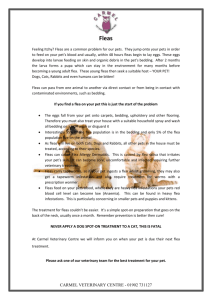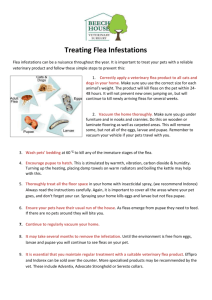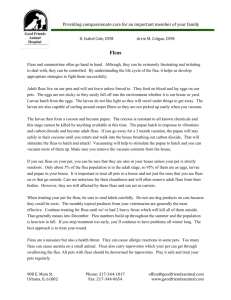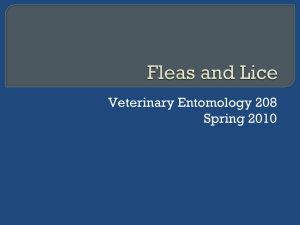What are fleas? - Integrated Pest Management
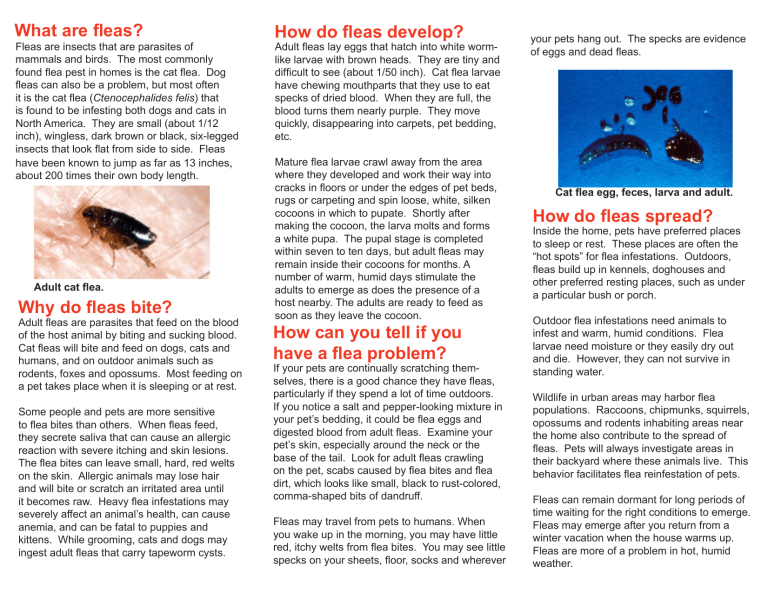
What are fleas?
Fleas are insects that are parasites of mammals and birds. The most commonly found flea pest in homes is the cat flea. Dog fleas can also be a problem, but most often it is the cat flea ( Ctenocephalides felis ) that is found to be infesting both dogs and cats in
North America. They are small (about 1/12 inch), wingless, dark brown or black, six-legged insects that look flat from side to side. Fleas have been known to jump as far as 13 inches about 200 times their own body length.
,
Adult cat flea.
Why do fleas bite?
Adult fleas are parasites that feed on the blood of the host animal by biting and sucking blood.
Cat fleas will bite and feed on dogs, cats and humans, and on outdoor animals such as rodents, foxes and opossums. Most feeding on a pet takes place when it is sleeping or at rest.
Some people and pets are more sensitive to flea bites than others. When fleas feed, they secrete saliva that can cause an allergic reaction with severe itching and skin lesions.
The flea bites can leave small, hard, red welts on the skin. Allergic animals may lose hair and will bite or scratch an irritated area until it becomes raw. Heavy flea infestations may severely affect an animal’s health, can cause anemia, and can be fatal to puppies and kittens. While grooming, cats and dogs may ingest adult fleas that carry tapeworm cysts.
How do fleas develop?
Adult fleas lay eggs that hatch into white wormlike larvae with brown heads. They are tiny and difficult to see (about 1/50 inch). Cat flea larvae have chewing mouthparts that they use to eat specks of dried blood. When they are full, the blood turns them nearly purple. They move quickly, disappearing into carpets, pet bedding, etc.
Mature flea larvae crawl away from the area where they developed and work their way into cracks in floors or under the edges of pet beds, rugs or carpeting and spin loose, white, silken cocoons in which to pupate. Shortly after making the cocoon, the larva molts and forms a white pupa. The pupal stage is completed within seven to ten days, but adult fleas may remain inside their cocoons for months. A number of warm, humid days stimulate the adults to emerge as does the presence of a host nearby. The adults are ready to feed as soon as they leave the cocoon.
How can you tell if you have a flea problem?
If your pets are continually scratching themselves, there is a good chance they have fleas, particularly if they spend a lot of time outdoors.
If you notice a salt and pepper-looking mixture in your pet’s bedding, it could be flea eggs and digested blood from adult fleas. Examine your pet’s skin, especially around the neck or the base of the tail. Look for adult fleas crawling on the pet, scabs caused by flea bites and flea dirt, which looks like small, black to rust-colored, comma-shaped bits of dandruff.
Fleas may travel from pets to humans. When you wake up in the morning, you may have little red, itchy welts from flea bites. You may see little specks on your sheets, floor, socks and wherever your pets hang out. The specks are evidence of eggs and dead fleas.
Cat flea egg, feces, larva and adult.
How do fleas spread?
Inside the home, pets have preferred places to sleep or rest. These places are often the
“hot spots” for flea infestations. Outdoors, fleas build up in kennels, doghouses and other preferred resting places, such as under a particular bush or porch.
Outdoor flea infestations need animals to infest and warm, humid conditions. Flea larvae need moisture or they easily dry out and die. However, they can not survive in standing water.
Wildlife in urban areas may harbor flea populations. Raccoons, chipmunks, squirrels, opossums and rodents inhabiting areas near the home also contribute to the spread of fleas. Pets will always investigate areas in their backyard where these animals live. This behavior facilitates flea reinfestation of pets.
Fleas can remain dormant for long periods of time waiting for the right conditions to emerge.
Fleas may emerge after you return from a winter vacation when the house warms up.
Fleas are more of a problem in hot, humid weather.
What do you do when you find fleas?
If you have a flea problem, you must treat your pets. Consult your veterinarian for the best methods to control fleas. Some pet products are not as safe as others. Be very careful about which pesticide product you choose. Pets may ingest pesticides that have been sprayed or dusted on when they groom themselves, and some pets are more sensitive to pesticides than others.
Make sure you use products that are labeled for flea control on your particular pet. Do not use a cat product on a dog and vice versa. Follow all label directions. It may be necessary to wear gloves or other protective equipment when applying the product. Keep children away from flea control products, and do not let them handle pets that have been recently treated.
New ly developed “spot-on” formulations are safer and easier to use than traditional insecticide dusts, sprays and shampoos.
These new products contain insect growth regulators (IGRs) that are less toxic to people collars. ea
S pecial flea combs are available to help you remove fleas from short-haired pets. Bathing your pet also helps to drown adult fl eas.
Prevention is the best approach to man age fleas.
Pets can receive a flea preventative on a regular basis in the form of a pill or food additive. These products can prevent the establishment of flea populations in homes .
I f fleas do become established, it is important to identify flea “hot spots” and concentrate your control efforts in those areas.
T
■
■
■ o control fleas indoors :
Vacuum floors, rugs, furniture and other sur faces where your pet sleeps, eats and sits.
This will pick up adult fleas, eggs, and larvae.
Also vacuum crevices around baseboards, behind doors, and under furniture, cabinets and appliances. Toss the vacuum bag out immediately when done.
Wash all pet bedding in hot water and dry in a hot drier, if possible, at least once per week
Steam clean or shampoo carpets, rugs and furniture. You may notice fleas after clean ing because they may hatch from the warmth of the water. Keep vacuuming, washing and cleaning until the fleas are gone.
In addition to cleaning and vacuuming, several insecticides are registered for controlling fleas indoors. IGR products are generally the safest type of insecticide products to use. They can be applied with a hand sprayer or aerosol can, or as a total release aerosol (i.e., flea bomb or room fogger). Follow label directions carefully on these products to protect your family’s and your pets’ health. The pupae are unaffected by the insecticide so you may still see some adult fleas emerg ing for up to two weeks after the treatment.
Consider outdoor controls when flea infestations are repeatedly being reintroduced. To control fleas
■
■
■
Remove debris and low-hanging vegetation to open areas to sunlight and help reduce fleas.
Close off crawl spaces, areas under porches, and openings into basements and attics where pets or wild animals nest.
Treat kennels, dog runs, doghouses and perimeter fences. Random sprays are not as effective as granular products targeted to treat infested areas.
New, May 2007. Developed by the MSU Pesticide Safety Education
Program, B18 Food Safety and Toxicology Building, Michigan State
University, East Lansing, MI 48824 (http://www.pested.msu.edu) and the Michigan Department of Agriculture.
MSU is an affirmative-action, equal-opportunity employer. Michigan State University Extension programs and materials are open to all without regard to race, color, national origin, gender, religion, age, disability, political beliefs, sexual orientation, marital status, or family status.
Issued in furtherance of MSU Extension work, acts of May 8 and June 30, 1914, in cooperation with the U.S. Department of Agriculture, Thomas G. Coon, Extension Director, Michigan State
University, East Lansing, MI 48824.
